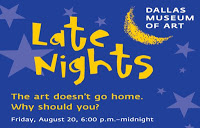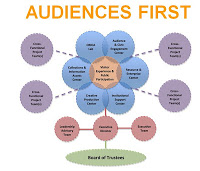
As is often true, I found that talking to other sectors about what we do made me solidify some of my thinking. Here is the entire talk if you want to watch [20 minute video]:
Here’s the catch: In balancing this equation, a museum gets to set the value of only one variable—the one that represents its core purpose, the heart of what it exists to deliver. The staff, board, volunteers have to be willing to experiment with all the other variables.
Museums have to let go of all of the assumptiond that have set the historical values of the equations that used to work. They need to find the one true thing that defines their identity, and then figure out how to let everything else morph as the world changes.
Some of the assumptions museums are having to let go of, for example, are about:
Place. There was a major study last year by the University of Chicago—Set in Stone—about the cultural building boom that took place between 1994 and 2008. There was unprecedented growth and building the nonprofit sector – museums, performing arts centers and theaters. The presumption was that if you had a big name architect create a major new cultural center, people would come use it. Often that assumption turned out to be wrong. Of the projects the report identified and studied, 80% went over budget, some by as much as 200%, and often the attendance projections were dead wrong. If you build it, they will not come, unless it serves a community need. That was an assumption that didn’t hold up.
 Time. The era of the old 9 to 5, Tuesday through Sunday museum is dead. That’s not when people live their lives; that’s not when they have free time. We see more and more museums experimenting with being open into the evening; even with being open all night. When the Dallas Museum of Art experimented with this, they had people lined up at 2 and 3 in the morning to get into the museum, because that was a cool time to be there.Content. Consider the first Internet Cat Video Festival held at the Walker Art Center in Minneapolis last year. It attracted 10,000 people to sit on their lawn and watch YouTube videos projected on a big screen. This event was so popular it’s now gone on the road and may be coming soon to a museum near you. Was it serious content? Actually, to paraphrase one professor commenting on the festival, ‘this is material culture. One of the most important things a museum can do is help people think critically about material culture and about emerging forms of art.’ So yes, this was very to-the-point of their mission.
Time. The era of the old 9 to 5, Tuesday through Sunday museum is dead. That’s not when people live their lives; that’s not when they have free time. We see more and more museums experimenting with being open into the evening; even with being open all night. When the Dallas Museum of Art experimented with this, they had people lined up at 2 and 3 in the morning to get into the museum, because that was a cool time to be there.Content. Consider the first Internet Cat Video Festival held at the Walker Art Center in Minneapolis last year. It attracted 10,000 people to sit on their lawn and watch YouTube videos projected on a big screen. This event was so popular it’s now gone on the road and may be coming soon to a museum near you. Was it serious content? Actually, to paraphrase one professor commenting on the festival, ‘this is material culture. One of the most important things a museum can do is help people think critically about material culture and about emerging forms of art.’ So yes, this was very to-the-point of their mission.
Format. Museums don’t have to be constrained by the traditional four walls, inviting you come and visit the museum. The museum may come to you. One example of such mobile, distributed museum experiences is the BMW Guggenheim Lab that’s now traveling the world. It’s a massive portable pop-up museum that helps cities examine their thoughts about design. It sets up in New York, in Berlin, in Mumbai, and it says “come talk to us about urban design. What do you want the city to look like? What are the elements of design that make a city livable?”
Scale. A museum like the National Gallery of Art can be tremendously proud if they have 4 million attendees a year. With an ambitious plan, maybe they can shoot for 10% increase per year scaling them up to 102 million more visitors per year after 33 years. As the Smithsonian’s director of Web and New Media Strategy, Michael Edson, says about scale, the internet now reaches 2.4 billion people. Does that make you feel a little small? Should a truly national museum with international aspirations be thinking about how to scale up 10, 20, 100, 1000 times? Conversely, are there museums that traditionally in their mission statements say “we want to be world class”? Should they be thinking smaller? Should they be looking at their local audience and asking how they can best serve their community?
 |
| Oakland Museum of California Organizational Chart Courtesy of Lori Fogarty |
Structure and authority. These organizational assumptions often hobble all of the other variables, keeping them artificially pegged to dysfunctional values. The traditional museum where the director was in charge of curators who had all the status and authority, who told the educators what they could go interpret in the exhibits, that’s all changing. We have museums like the Oakland Museum of California restructuring their entire organizational chart to center on the community, to say “what is the community’s opinion of what we should be collecting and preserving and interpreting?” Because that is the core of their purpose.
In the end, when that equation balances successfully, it’s because you’ve found a core purpose that is either essential (people cannot live without it), it’s addictive (people don’t want to live without it), or ideally both.










Hi! Great article. Just wanted to make a correction: the name of the Oakland Museum of California is right in the post, but the label for the 'Audiences First' chart calls it the 'Oakland Museum of Art.' This could be confusing for folks, since the Oakland Museum of Art doesn't exist!
Thanks!
Thanks for catching the error, Claudia! Fixed it.